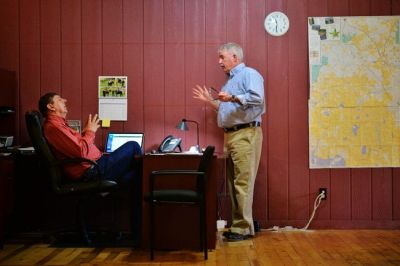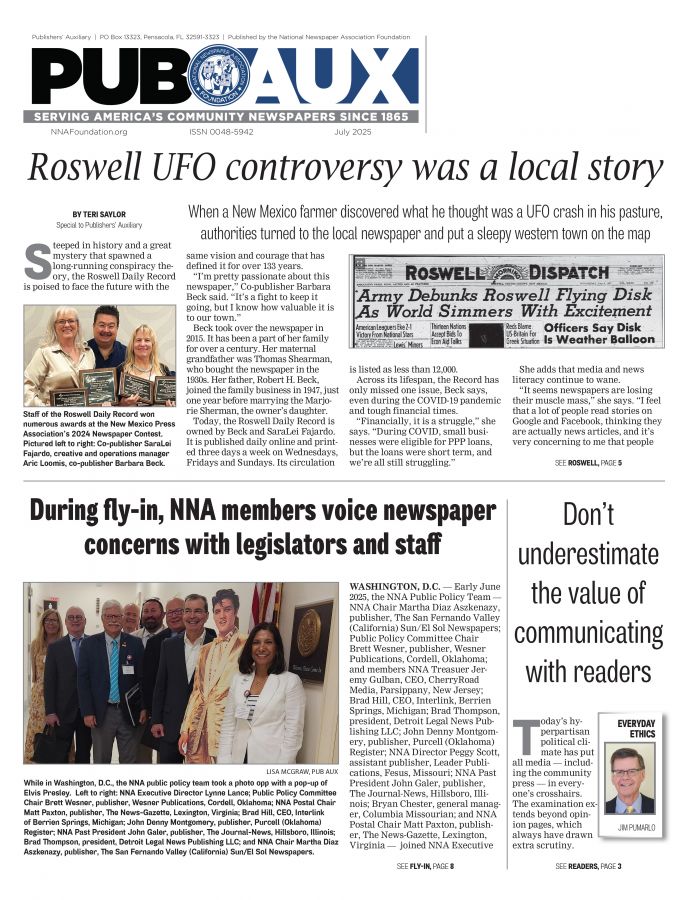Les Zaitz rescues a struggling weekly and elevates local news to award-winning journalism
Teri Saylor
Special to Publishers' Auxiliary
Dec 1, 2019

On a chilly day a week before Thanksgiving, Les Zaitz couldn’t stay on the phone long. He was preparing to welcome a pair of donkeys to his ranch and had work to do. He is most happy when he’s building fences, feeding cows and horses and helping animals in need.
Zaitz, who spent his career uncovering corruption, ferreting out wrongdoing and racking up awards as an investigative reporter, was looking forward to living his lifelong dream of retiring to a ranch and riding off into the sunset.
That is, until 2015, when the Malheur Enterprise, a 110-year old, tiny weekly newspaper in Vale, Oregon, called his name. Zaitz traveled the 100 miles from his ranch to the paper and observed a typical weekly that needed some tough love and a major overhaul. This rancher, who loves rescuing animals, saw a newspaper that needed rescuing, too.
“I had heard the newspaper was for sale and struggling,” he said. “I was a year out from retirement, but I thought I’d take a look at it.”
What he saw was possibly the worst newspaper in Oregon.
“I say the worst because it was filled with press releases and guest columnists who were public officials in Salem, the state capital, over 300 miles away,” he said.
The newspaper had one reporter with no training, experience or editorial direction who was doing the best he could but was producing mediocre news articles. The last advertising salesperson had left 10 years earlier and had never been replaced.
“The newspaper published only the ads that came in the door,” he said. “The owner was a former music critic who lived in Tacoma, Washington, and circulation was steadily declining, except for the readers who wanted to keep up with high school sports.”
Zaitz called the entire operation “a recipe for disaster.” And then he, his wife Scotta Callister, and his brother Lyndon Zaitz, bought the newspaper anyway.
“I am sharply aware of how newspapers are vitally important to the communities they serve, particularly in rural areas,” he said. “I looked at the newspaper. I looked at the community, and I diagnosed the problems. I decided to buy it and try to keep it alive, and I thought we could make it sustainable.”
The population in Vale is 1,825, and the newspaper’s circulation is 1,500. The closest daily newspaper is the Argus Observer in Ontario, Oregon.
Malheur County covers a vast landscape spanning nearly 10,000 square miles in Oregon, sharing its eastern border with Idaho and its southern border with Nevada. Much of the land is federally owned. The county is named for the Malheur River, which flows through it. Malheur is a French word that means “misfortune” in English. In a Pacific coast state, Malheur is the only county in the Mountain time zone.
The U.S. Census estimates that Malheur County is home to about 31,000 residents, and a third of the population is Hispanic. The county’s agrarian economy is known for cattle ranching, hay production, sugar beets and onions.
The Census also estimates only 13% of residents have a bachelor’s degree, and about a quarter of the population lives in poverty.
Zaitz, who is a two-time Pulitzer Prize finalist, also owns the Keizertimes in Keizer, Oregon, with his brother, who serves a publisher, and is the founding partner in Mazama Digital, formed in 2017 to design and market a content management system for online news operations.
In 2018, he co-founded Salem Reporter, a digital news service based in Oregon’s capital, and is the CEO and editor. Soon after its launch, Salem Reporter formed a collaboration with two other Oregon news organizations to create the Oregon Capital Bureau, focusing on state government report. Zaitz leads the team of three reporters as its editor.
“During the 2016 presidential election, trust in the media was eroding amidst the ‘fake news’ rallying cry,” Zaitz said. “In a small way, I wanted to use the Enterprise as a role model to test the theory that people want credible, local news that could be as professional and provide the same quality news as the Washington Post, New York Times and other great American dailies.”
Zaitz sees no journalistic difference between daily and weekly newspapers. The major difference is scale.
“Just because a newspaper is small doesn’t mean it is bad. Community newspapers must be trustworthy watchdogs, accountable to their communities,” he said. “This takes away the excuse that small newspapers don’t have enough resources to produce good journalism, and I can say this with some authority because I have a newsroom of two.”
He also employs a reporter funded through Report for America and usually takes on one or two paid interns per year.
The key to producing a quality newspaper with a small staff is to set priorities and avoid being predictable, he says.
If building a new revenue model was Zaitz’s first move after taking over the Enterprise, re-tooling news coverage was not far behind.
“I decided our reporters were no longer going to sit at local meetings, act at stenographers and report on boring topics,” he said. “If anything important is discussed, we should know about it before it gets to the meetings.”
He helped the reporters develop sources to keep them in the loop, and they learned to use the three hours they would have spent at school board meetings to dig into deeper issues, such as how migrant students are getting their education or why absenteeism is so high at local schools.
The newspaper’s turnaround began immediately after Zaitz bought it, but the coverage of two major events that had a powerful impact on the community was the turning point in its rebound.
The first was an unusually hard winter in 2017 when it snowed so much that more than 100 buildings collapsed.
“We became a 24/7 news source, using Facebook and our website to keep people posted on the weather conditions and where volunteers were needed,” Zaitz said. “Readers flocked to us. Our Facebook reach went through the roof and touched over 100,000 users. It was stunning to watch the metrics.”
The newspaper also covered a horrifying crime involving a local hospital that released a patient who had faked his mental illness and went on to kidnap and murder his wife in the front seat of his truck, evading capture until he crashed into another car, killing the driver, a local resident.
“We conducted an investigation on the killer, who he was, how he had been able to fake his illness, and then why he was released from the hospital,” Zaitz said.
The newspaper became embroiled in an ugly battle with the state’s justice department over public records in the case, which were finally released after the Oregon governor intervened.
The newspaper’s reporting led to an examination of how the state handles insanity defenses in criminal courts. The coverage earned the Enterprise the 2018 Investigative Reporters and Editors FOI Award, marking the first time in the award’s 20-year history that a community weekly newspaper has been the recipient.
This year, the Enterprise has been the subject of a criminal investigation brought by a disgruntled legislator who maintained lucrative economic development contracts with Malheur County. He claimed reporters were harassing his staff by emailing and calling them for quotes, comments and information about their work.
“Readers were outraged by his claims, and the sheriff didn’t take his threats seriously and refused to press charges,” Zaitz said. The Washington Post reported on the investigation last August.
Zaitz, who values transparency, runs a no-frills website, which includes an extensive statement of principles and a description of how the newspaper’s journalists work. The website also makes a case for why it is important to pay for news. A donation site raises money to pay interns, and subscriptions are $5 a month. The newspaper also offers a free trial subscription for new readers. The newspaper relies on postal delivery and is available on newsstands. Both the website and Facebook page serve as its around-the-clock platform for all news, including developing events.
Zaitz runs the Enterprise from his ranch.
“I don’t go to the office every day because I don’t want the newspaper resting on my shoulders, and I don’t want to be the face of the newspaper,” he said. “Our staff is well-organized, and I can manage it just as easily by phone and Skype.”
He predicts that while community newspapers will remain in print for another decade because current readers are used to holding it in their hands, eventually, journalism will migrate to digital platforms. The quality of coverage will dictate whether these platforms will rise or fall.
“Overall, the future of journalism depends on us. We need to return to the basics and return trust,” he said. “I believe we should first focus on content and then worry about delivery.”
Teri Saylor is a freelance writer in Raleigh, North Carolina. Contact her at 919-604-0288.










